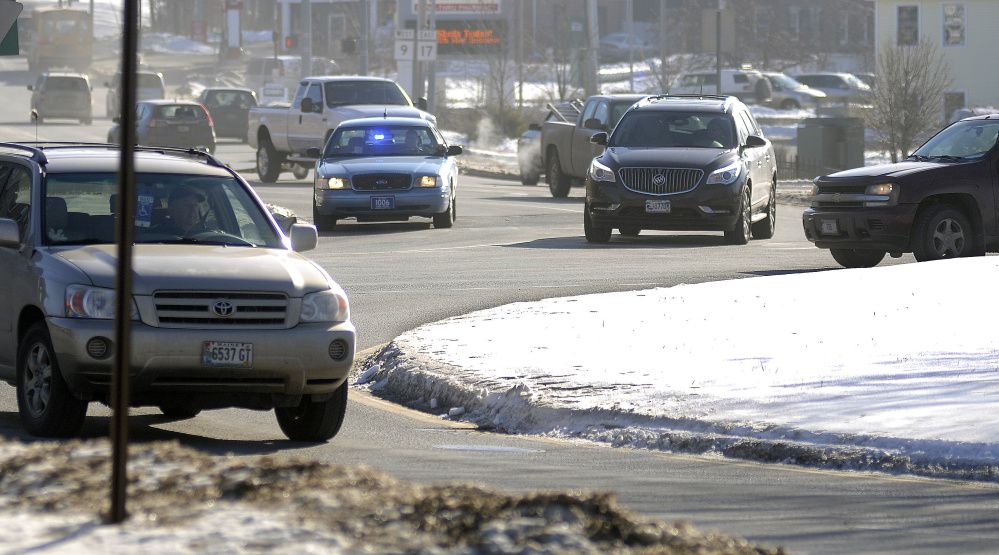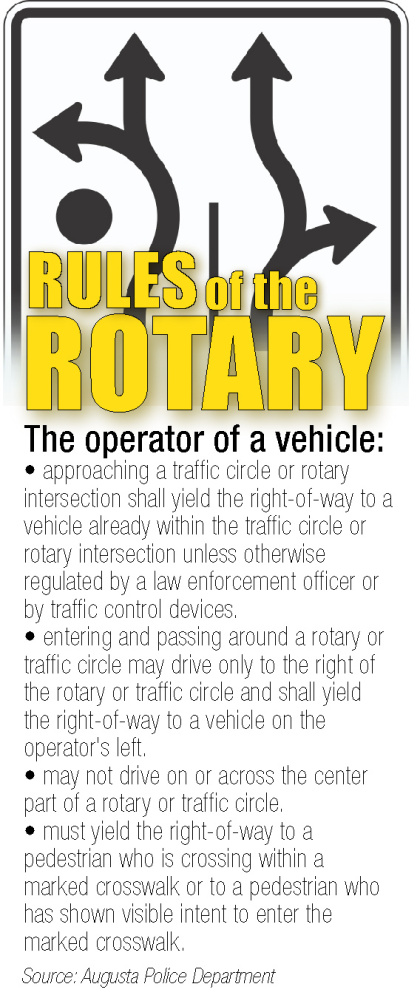AUGUSTA — This city may be as well known for its rotaries as it is for its politicians. And while it’s a good idea to pay attention when dealing with both, it’s the rotaries that have captured most of the attention of city police.
Police officials have announced plans to step up education and enforcement efforts at the city’s two in-town rotaries to increase safety for both drivers and pedestrians. Officials say the initiative has not been sparked by a single event at either rotary – the Memorial Circle at the end of Western Avenue and Cony Circle at the end of Bangor Street – but rather a cumulative problem of speeding drivers and oblivious pedestrians.
“As many may already know, these two locations can be difficult to navigate due in part to some motorists being in a hurry, traveling speeds unsafe for the road condition, traveling too close to the vehicle in front of them and failing to stop for pedestrians in the crosswalks,” Deputy Chief Jared Mills said in a news release. “It is our hope through education and enforcement that we can improve the overall safety of these areas within our city through voluntary compliance.”
WHEN TO YIELD
Mills said state law requires drivers approaching a rotary to yield to those already in the rotary. Drivers inside the rotary are required to give way to vehicles on the driver’s left.
Moreover, Mills said, laws protecting pedestrians apply to rotaries as well as traditional streets. He said drivers must yield the right of way to a pedestrian who is crossing within a marked crosswalk or to a pedestrian who “has shown visible intent” to enter a crosswalk.
“With this initiative, it is our hope to make it safer for both motorists and pedestrians,” Mills said.
While serious crashes are a rarity, the rotaries have been the scene of hundreds of bent fenders over the decades. There were 216 crashes on the east-side Cony Circle in the five years from 2010 to 2014, according to the Maine Department of Transportation. The number of crashes peaked at 55 in 2012 but dropped off to 47 and 43 respectively over the next two years.
One of those crashes included a pedestrian and one included a bicyclist. None of the crashes caused more than minor injury.
The most common factors in the crashes, according to the state, are failure to yield right of way, following too closely and failure to keep in the proper lane.
The numbers are similar on the west-side Memorial Circle, where there were 183 crashes in the five years between 2010 and 2014. The peak year during that time was 2013, in which 37 crashes occurred.
The crashes included two pedestrians and two people on bicycles. None of the crashes caused more than minor injury.
As is the case on Cony Circle, the most common factors in the crashes, according to the state, are failure to yield right of way, following too closely and failure to keep in the proper lane.
DRIVERS STILL GOING TOO FAST
Cony Circle crashes dropped precipitously after a 2008 reconfiguration improved markings and traffic flow. There were 160 accidents in the 18 months before reconstruction started on the traffic circle in 2008, according to the state. In the 18 months after the work ended, there were 80 accidents – a 50 percent cut.
While that decline is good news to Augusta police, Chief Robert Gregoire said safety on the rotaries is a regular discussion topic among the department’s officers. Gregoire said drivers in both rotaries still are going too fast and paying too little attention to the rules.
“The more people that slow down, the more people that will slow down because they’re forced to slow down,” Gregoire said.
He said police hope to drive the message home through a combination of education and enforcement. Education, Gregoire said, could include traffic stops that result in a warning, in addition to public service messages. The enforcement, Gregoire said, could include dedicated patrols and even plainclothes officers acting as pedestrians trying to cross the street.
“What we’d really like to see is people slow down and voluntary compliance,” Gregoire said.
But improving safety will take more than the drivers, Gregoire said. Pedestrians, too, can help by paying attention to traffic and using crosswalks. Gregoire said officers will stop pedestrians who fail to do so.
“It’s just as much to educate the pedestrians,” Gregoire said.
He said there is a growing trend of people crossing the street outside of a crosswalk, without looking for oncoming traffic or otherwise not paying attention to their surroundings. Gregoire said drivers have been warned against such behavior for years.
“We tell people to drive defensively,” Gregoire said. “Pedestrians need to walk defensively.”
Craig Crosby can be contacted at 621-5642 or at:
ccrosby@centralmaine.com
Copy the Story LinkSend questions/comments to the editors.




Success. Please wait for the page to reload. If the page does not reload within 5 seconds, please refresh the page.
Enter your email and password to access comments.
Hi, to comment on stories you must . This profile is in addition to your subscription and website login.
Already have a commenting profile? .
Invalid username/password.
Please check your email to confirm and complete your registration.
Only subscribers are eligible to post comments. Please subscribe or login first for digital access. Here’s why.
Use the form below to reset your password. When you've submitted your account email, we will send an email with a reset code.